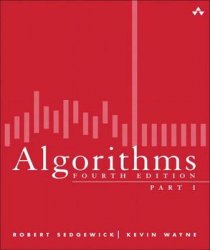 Название: Algorithms: Part I, 4th Edition
Название: Algorithms: Part I, 4th Edition Автор: Robert Sedgewick, Kevin Wayne
Издательство: Addison-Wesley Professional
Год: 2014
Страниц: 531
Язык: английский
Формат: pdf (true)
Размер: 25.0 MB
This book is Part I of the fourth edition of Robert Sedgewick and Kevin Wayne’s Algorithms, the leading textbook on algorithms today, widely used in colleges and universities worldwide. Part I contains Chapters 1 through 3 of the book. The fourth edition of Algorithms surveys the most important computer algorithms currently in use and provides a full treatment of data structures and algorithms for sorting, searching, graph processing, and string processing -- including fifty algorithms every programmer should know. In this edition, new Java implementations are written in an accessible modular programming style, where all of the code is exposed to the reader and ready to use.
The algorithms in this book represent a body of knowledge developed over the last 50 years that has become indispensable, not just for professional programmers and computer science students but for any student with interests in science, mathematics, and engineering, not to mention students who use computation in the liberal arts.
An online synopsis
Full Java implementations
Test data
Exercises and answers
Dynamic visualizations
Lecture slides
Programming assignments with checklists
Links to related material
he objective of this book is to study a broad variety of important and useful algorithms—methods for solving problems that are suited for computer implementation. Algorithms go hand in hand with data structures—schemes for organizing data that leave them amenable to efficient processing by an algorithm. This book introduces the basic tools that we need to study algorithms and data structures. First, we introduce our basic programming model. All of our programs are implemented using a small subset of the Java programming language plus a few of our own libraries for input/output and for statistical calculations. Section 1.1 is a summary of language constructs, features, and libraries that we use in this book.
Next, we emphasize data abstraction, where we define abstract data types (ADTs) in the service of modular programming. In Section 1.2 we introduce the process of implementing an ADT in Java, by specifying an applications programming interface (API) and then using the Java class mechanism to develop an implementation for use in client code.
As important and useful examples, we next consider three fundamental ADTs: the bag, the queue, and the stack. Section 1.3 describes APIs and implementations of bags, queues, and stacks using arrays, resizing arrays, and linked lists that serve as models and starting points for algorithm implementations throughout the book. Performance is a central consideration in the study of algorithms. Section 1.4 describes our approach to analyzing algorithm performance. The basis of our approach is the scientific method: we develop hypotheses about performance, create mathematical models, and run experiments to test them, repeating the process as necessary.
Скачать Algorithms: Part I, 4th Edition